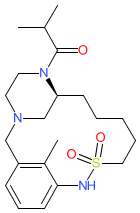GtoPdb is requesting financial support from commercial users. Please see our sustainability page for more information.
|
Compound class:
Synthetic organic
Comment: This macrocyclic compound is reported as an inverse agonist of retinoic acid receptor-related orphan receptor C2 (RORC2 or RORγt), which is a receptor isoform that's produced from the nuclear hormone receptor-encoding RORC gene in immune cells [1]. It was designed as an anti-inflammatory agent, for topical application.
Ligand Activity Visualisation ChartsThese are box plot that provide a unique visualisation, summarising all the activity data for a ligand taken from ChEMBL and GtoPdb across multiple targets and species. Click on a plot to see the median, interquartile range, low and high data points. A value of zero indicates that no data are available. A separate chart is created for each target, and where possible the algorithm tries to merge ChEMBL and GtoPdb targets by matching them on name and UniProt accession, for each available species. However, please note that inconsistency in naming of targets may lead to data for the same target being reported across multiple charts. ✖ |
|
|||||||||||||||||||||||||||||||||||
| Immunopharmacology Comments |
| RORγt is a nuclear hormone receptor that regulates the expression of pro-inflammatory interleukin-17A (and IL-17F) in T-helper 17 (Th17) cells. Selective inhibition of RORγt's transcriptional activity is targeted as a novel anti-inflammatory mechanism. This small molecule is an alternative approach to the approved anti-IL-17A and IL-17 receptor (IL17RA) monoclonal antibodies that are in clinical use as psoriasis, psoriatic arthritis, and ankylosing spondylitis therapeutics (see the entries for secukinumab, ixekizumab, brodalumab). |







